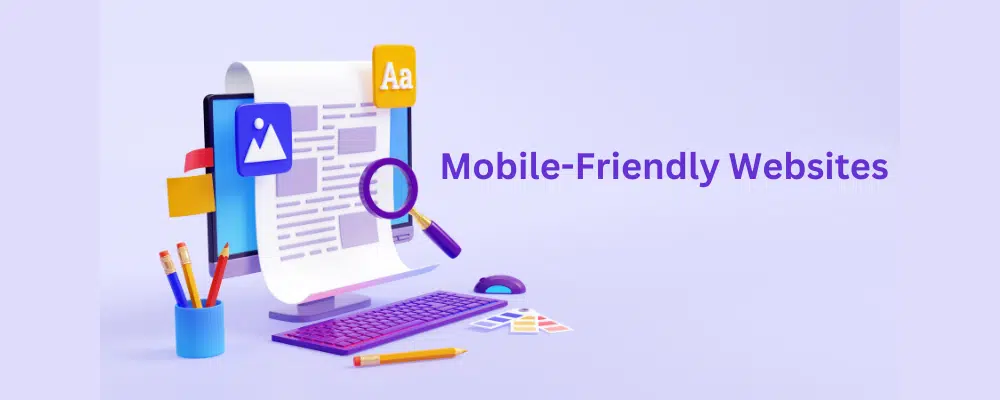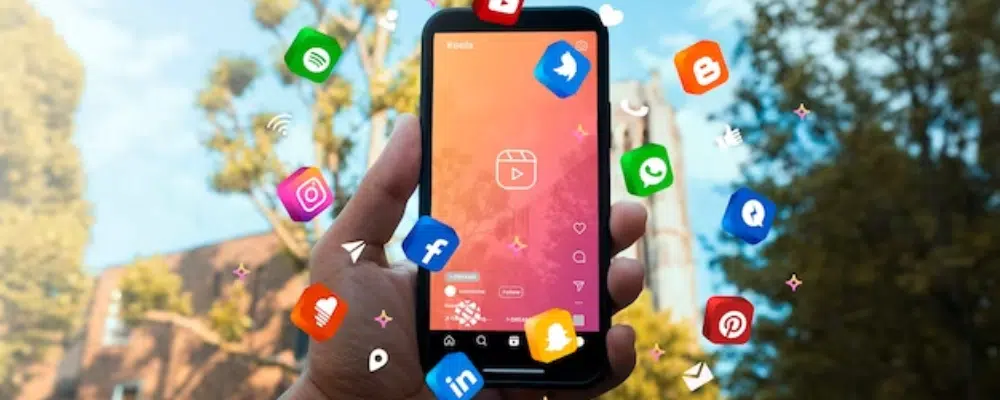In a world where information flows at the speed of light and opportunities are seized in the blink of an eye, your business’s ability to capture leads swiftly and effectively is paramount. Step into the era of Mobile Revolution in Lead Generation, where the potential to turn occasional visitors into loyal customers lies right in the palm of your hand.
The average person spends nearly three hours a day on their mobile device, a portal to a digital realm brimming with endless potential. From shopping for essentials to exploring new horizons, the mobile phone has become an extension of ourselves, and the implications for lead generation are nothing short of groundbreaking.
We’ll try here to unveil how mobile devices are not just gadgets but gateways to your audience’s hearts. It’s time to harness the seismic shifts in consumer behavior, adapt your strategies to the smallest of screens, and master the art of reaching out, capturing, and nurturing leads like never before. So, we navigate this digital frontier and explore the transformative power of the Mobile Revolution in Lead Generation.
The Rise of Mobile Usage
In our fast-paced, digitally driven world, mobile devices have become more than just gadgets; they’re an integral part of our lives. To truly grasp the extent of the mobile revolution in lead generation, we must first examine the staggering statistics that underscore its prominence.
Smartphone Penetration: The penetration of smartphones is nothing short of astonishing. Globally, more than 3.8 billion people wield these pocket-sized powerhouses, accounting for nearly half of the world’s population. This widespread adoption has ushered in an era of unparalleled accessibility.
Tablet Takeover: But it’s not just smartphones leading the charge; tablets have also found their way into countless households. Over 1.5 billion people use tablets, making them a versatile platform for online interactions, from entertainment to shopping.
Mobile Internet Usage: The rise of mobile internet usage is remarkable. Today, around 54% of all global web traffic is generated by mobile devices. It’s not merely an option; it’s the preferred choice for accessing information, products, and services.
App Ecosystem: Mobile app usage is booming as well. App stores boast millions of apps, and the average smartphone user has around 80 apps installed. This dynamic ecosystem presents an abundance of opportunities for lead generation within the digital realms of these applications.
These statistics paint a vivid picture of the mobile landscape, illustrating the ubiquity and potential for businesses to connect with their audience like never before.
Mobile-Friendly Websites
In an age where the world fits into the palm of your hand, your online presence must be as adaptable as it is compelling. Mobile-friendly websites are not a luxury; they’re a necessity in the era of the mobile revolution in lead generation.

Responsive web design is not just a buzzword; it’s the cornerstone of an exceptional user experience. It’s the process of creating websites that automatically adjust and scale to fit various screen sizes, be it a smartphone, tablet, or desktop. The importance of responsive design lies in universal access. Regardless of the device, screen size, or orientation, your website’s content remains accessible and visually appealing. Gone are the days of zooming in and out or squinting at tiny text on mobile screens.
Mobile Optimization Techniques
Creating a responsive design is just the beginning; to truly optimize your website for mobile, you need to employ a set of best practices that cater specifically to the mobile experience:
- Mobile users demand speed. Slow-loading pages can lead to high bounce rates and lost leads. Compress images, reduce unnecessary scripts, and leverage browser caching to enhance page loading times. A faster website not only pleases users but also ranks higher in search results.
- Streamline your website’s navigation for mobile users. Simplify menus, use clear and concise labels, and implement a mobile-friendly menu structure. Avoid overwhelming visitors with complex menus that may frustrate them and drive them away.
- Mobile search engine optimization is paramount. Tailor your content to mobile users by ensuring it’s concise, scannable, and provides quick answers to common queries. Use mobile-specific keywords and optimize your site for local search if applicable.
- Keep in mind that mobile users primarily navigate with their thumbs. Place important elements, such as call-to-action buttons, within easy reach of the user’s thumb, ensuring a comfortable and efficient interaction.
By implementing responsive design and mastering mobile optimization techniques, your website becomes a powerful tool in lead generation. It not only adapts to the mobile era but thrives in it, providing an exceptional user experience and maximizing your chances of converting mobile visitors into valuable leads.
Mobile Apps for Lead Generation
Mobile apps are not just a trend; they’re a strategic avenue for businesses to engage with their audience and cultivate leads like never before. They offer a unique channel for lead generation, and their benefits extend far beyond a mere digital presence. They provide an enhanced user experience, offering a smoother and more immersive interaction compared to mobile websites. Personalization is a significant advantage; apps allow you to collect user data and preferences, enabling you to deliver personalized content, offers, and recommendations, making lead generation more targeted and effective. The use of push notifications, a feature exclusive to apps, is a powerful tool for re-engaging users, promoting offers, and encouraging specific actions, which is vital for nurturing leads. Also, apps can store information locally, allowing users to access content even when they’re offline, a valuable feature in industries where consistent internet access isn’t guaranteed.
In-App Lead Generation
Once your app is up and running, it’s time to explore effective in-app lead generation strategies. Incorporate lead capture forms and pop-ups within the app, offering incentives like discounts or exclusive content in exchange for user information. Create interactive quizzes, surveys, or tools to encourage user engagement and collect valuable lead data. Utilize push notifications strategically to prompt users to take specific actions, such as signing up for a newsletter or attending a webinar. Implement in-app messaging to guide users toward lead-generating actions, such as scheduling a demo or making a purchase. Finally, consider loyalty programs to reward users for their loyalty with a point-based system, discounts, or exclusive offers that are accessible through the app.
Successful in-app lead generation is about creating a seamless user experience while subtly guiding users toward becoming leads. Examples abound, from e-commerce apps offering exclusive discounts to news apps offering personalized content in exchange for user information. The possibilities are limitless, and it’s all about creative and strategic implementation to maximize lead generation within your mobile app.
SMS and Mobile Marketing
In a world inundated with digital marketing channels, SMS and mobile advertising stand out as potent tools for lead generation. SMS marketing, or text message marketing, has emerged as a highly effective lead generation strategy for several reasons. The immediacy and intimacy of SMS communication often yield impressive results. Messages are typically read within minutes of receipt, making it a swift and reliable method for reaching your audience. Moreover, SMS marketing boasts high open and conversion rates, making it particularly adept at capturing leads.

Mobile advertising is another dynamic facet of lead generation, encompassing a wide range of options such as in-app ads, mobile banners, and more. The ubiquity of mobile devices has turned them into valuable advertising platforms, and businesses have tapped into this space to engage with their audience. In-app advertising involves promoting products or services within mobile applications. These ads can be highly targeted and contextual, offering users relevant content while they engage with their chosen apps. Mobile banners are graphic ads that appear at the top or bottom of a mobile screen. These are designed to capture users’ attention without being overly intrusive.
The role of mobile advertising in lead generation is profound. With the vast number of users spending considerable time on mobile apps and websites, strategically placed ads can drive user engagement and lead generation. By crafting compelling, visually appealing advertisements and targeting the right audience, mobile advertising can be a powerful means of capturing leads.
Social Media and Mobile Leads
As the digital landscape continues to evolve, it’s essential for businesses to embrace the mobile-first approach on social media platforms and harness the potential of mobile video marketing. Social media has seen a fundamental shift towards mobile-first platforms. These are designed to offer a seamless and engaging user experience on smartphones and tablets. As the majority of social media users access these platforms via mobile devices, understanding how to leverage these platforms for lead generation is pivotal.
Optimized for mobile, platforms like Instagram, Snapchat, and TikTok have risen to prominence. They emphasize visual content, short-form videos, and interactive features that cater to the preferences of mobile users. To harness the lead generation potential of these platforms, consider these strategies:
Engaging Visual Content: Create visually appealing and shareable content that aligns with the platform’s nature. Use eye-catching graphics, images, and videos that resonate with your target audience.
Short, Snappy Messaging: Mobile users often have limited attention spans. Craft concise and attention-grabbing messages that get to the point quickly.
Storytelling: Take advantage of features like Instagram Stories or Snapchat to tell your brand’s story in a way that connects with your audience. Stories can be an excellent tool for lead generation through interactive elements like polls and quizzes.
Use Hashtags Wisely: Integrate appropriate hashtags into your content to enhance its visibility and discoverability.. This can help reach a broader audience and capture potential leads.
Direct Messaging: Encourage direct communication with your audience through features like Instagram Direct or private messaging on other platforms. This one-on-one interaction can lead to more personal connections and, ultimately, lead generation.
Mobile Video Marketing
The surge in mobile video consumption represents a profound shift in digital marketing. With an increasing appetite for video content, businesses must adapt their lead generation strategies accordingly. Short-form videos, like those on TikTok and Instagram Reels, have become exceptionally popular. Crafting concise, engaging videos that prompt viewers to take action is a key strategy, as is offering informative and educational content to build trust and credibility, encouraging potential leads to engage. Incorporating interactive elements such as polls, quizzes, and call-to-action buttons within videos can further encourage user engagement and lead capture.

Live video streaming, available on platforms like Facebook Live and Instagram Live, presents a unique opportunity to engage with the audience in real time. These live streams can be harnessed for product demonstrations, Q&A sessions, or special announcements, providing immediate interaction and lead generation potential. It’s also vital to ensure video content is optimized for mobile devices, with responsive design and fast load times to deliver a seamless experience, regardless of the user’s chosen device. In the dynamic world of mobile-first social platforms and mobile video marketing, tailoring strategies to mobile users’ preferences and habits is the key to creating a meaningful connection with the audience and effectively capturing leads in the evolving digital landscape.
Mobile Analytics
Effective tracking of mobile leads requires the use of various tools and methods. This enables businesses to gain insights into user behavior on mobile devices and make informed decisions about their lead generation strategies. Mobile analytics play a crucial role in optimizing lead generation efforts. This involves utilizing A/B testing and data-driven decisions to enhance the effectiveness of mobile lead generation strategies.
Conclusion
Amidst the dynamic changes in lead generation strategies, the Mobile Revolution has emerged as a defining catalyst, fundamentally altering the way businesses engage with potential leads. From responsive web design to mobile apps, SMS marketing to mobile advertising, and mobile-first social platforms to video marketing, this revolution offers an array of powerful tools and strategies for capturing leads. Mobile analytics, too, guide businesses in refining their approach.
As the world becomes increasingly mobile-centric, adapting and excelling in these mobile-driven strategies isn’t just an option; it’s a necessity. The future of lead generation is here, and those who embrace it with creativity, adaptability, and data-driven precision will thrive in this new era of opportunity and connection. Embrace the Mobile Revolution in Lead Generation, where every touch, swipe, and click can lead to boundless possibilities.




